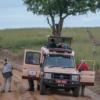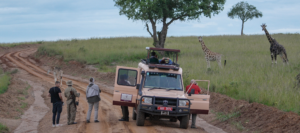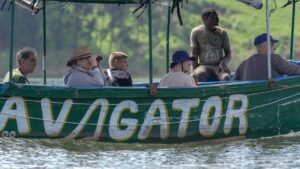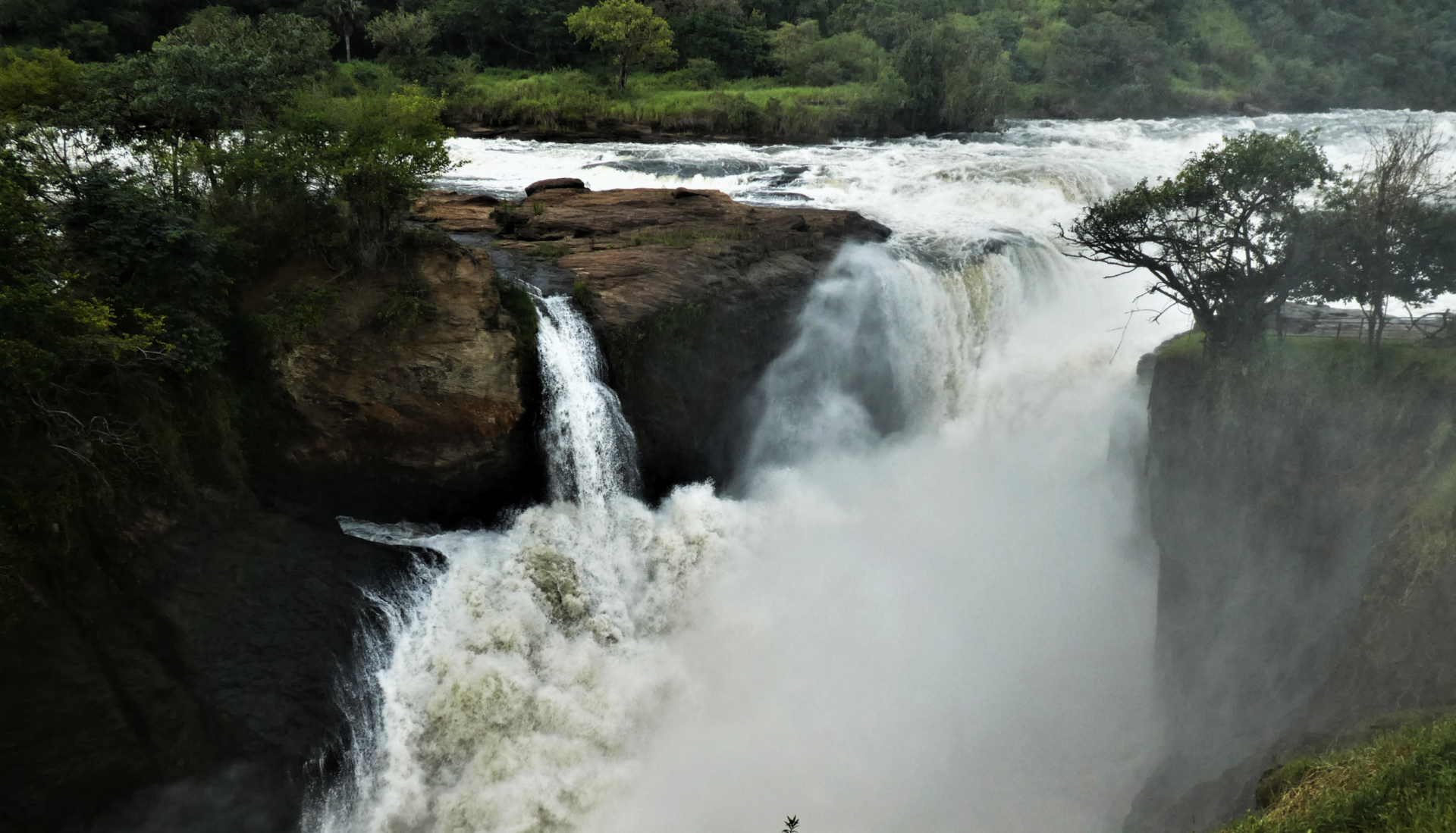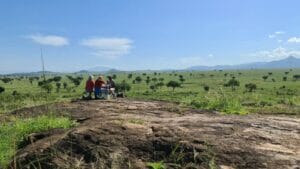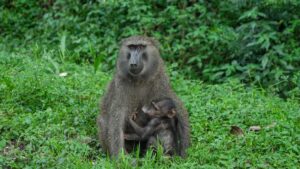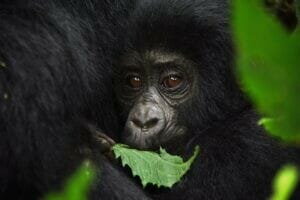If you’re looking to go gorilla trekking, you may be wondering if Uganda or Rwanda is the better option.
Both countries offer unique experiences when it comes to gorilla trekking, so it really depends on what you’re looking for.
Called the Land of a Thousand Hills, Rwanda is known for its impressive natural parks, birding, diverse wildlife, and beautiful lakes.
Uganda, or the Pearl of Africa, is home to many amazing primates, an intimate Big 5 animals experience, incredible natural landscapes, and more.
Besides sharing a border, one of the elements Uganda and Rwanda have in common is that it’s possible to track the endangered mountain gorilla.
Which one should you visit for your next East African safari? We break down the pros and cons of Uganda vs Rwanda for gorilla trekking below.
Rwanda vs. Uganda: Which is better for gorilla trekking?
Rwanda and Uganda are both great places for gorilla trekking. As there are only 1,063 mountain gorillas in the wild – and mountain gorillas only live in the wild – going on a mountain gorilla safari is one of the most amazing natural experiences available to us.
There are only three countries where you can go gorilla trekking: Rwanda, Uganda, and Congo. Given that the Congo’s mountain gorilla permits are currently unavailable, today we are focusing on Rwanda and Uganda.
Let’s start with three important differences between Uganda and Rwanda for gorilla trekking:
- Location: While both countries are located in East Africa (and you can get access to them both through the East Africa Tourist Visa), Uganda is located to the east and shares a border with Kenya, while Rwanda is located further to the south. Both share a border with Tanzania. Depending on how you’re thinking about planning your East African safari, your choice of country could mean more time enjoying the wilderness and less time traveling.
- Cost: A gorilla trekking permit in Uganda costs $800, while a gorilla trekking permit in Rwanda costs $1500. This is a significant difference and something to consider both if you are on a budget, traveling with a large group, and would like to potentially visit more than one gorilla family.
- Distance From The Airport: In Rwanda, Volcanoes National Park is just a few hours drive from the capital city, Kigali. In Uganda, getting from the capital to the border can either take a longer driver or another short flight. For travelers pressed for time, Rwanda can seem more convenient. For travelers who want to experience more of the country itself, Uganda may present more immersive opportunities.
Rwanda’s Volcanoes National Park vs. Uganda’s Bwindi Impenetrable National Park for Gorilla Trekking
The mountain gorillas of East Africa are most often visited in Volcanoes National Park in Rwanda and Bwindi Impenetrable National Park in Uganda. It is also possible to see mountain gorillas in Mgahinga Gorilla National Park.
If you’re looking to go gorilla trekking in Africa, you may be wondering whether Rwanda’s Volcanoes National Park or Uganda’s Bwindi Impenetrable National Park is the better option.
Here are three key differences between the two parks that may help you make your decision:
- Ease of Arrival: Volcanoes National Park is located in northwestern Rwanda, about two hours’ drive from the capital city of Kigali. Bwindi Impenetrable National Park, on the other hand, is located in southwestern Uganda, about a five-hour drive from the capital city of Kampala.
- Cost: A permit to trek gorillas in Volcanoes National Park costs $1,500, while a permit to trek gorillas in Bwindi Impenetrable National Park costs $800.
- Time: The average time to hike and find the gorillas in Volcanoes National Park is about two hours, while the average time to hike and find the gorillas in Bwindi Impenetrable National Park is about four hours. Once there, tourists may enjoy one hour with the normal gorilla permits. In Uganda, though, it is also possible to book a $1,500 gorilla habituation permit for a visit of up to 4 hours.
So, there you have it – three key differences between Rwanda’s Volcanoes National Park and Uganda’s Bwindi Impenetrable National Park. Ultimately, the best choice for you will come down to your budget, your schedule, and how long you are hoping to spend with the mountain gorillas.
Frequently Asked Questions About Mountain Gorilla Safaris
How much does it cost to see gorillas in Uganda?
The gorilla permit in Uganda costs $800 and allows you to spend one hour with a gorilla family. The gorilla habituation permit in Uganda costs $1500 and allows you to spend up to four hours with a gorilla family.
You can find an example of a 3-day gorilla safari itinerary here.
How much does it cost to see gorillas in Rwanda?
A gorilla permit in Rwanda costs $1500 per person. This includes the cost of the permit, which is required in order to see the gorillas.
Is it gorilla trekking or gorilla tracking?
Some people use the terms gorilla trekking and gorilla tracking interchangeably, but there is actually a difference between the two.
Gorilla tracking is the act of following gorillas in their natural habitat, observing their behavior and movements. Gorilla trekking involves actually going into the forest to find gorillas and then spending time with them.
What is gorilla habituation?
Gorilla habituation is the process whereby wild gorillas become accustomed to the presence of humans. This process generally takes many months, sometimes even years, and requires the dedication of a team of habituation experts.
The end goal of habituation is to allow humans to safely and comfortably observe gorillas in their natural habitat. Gorilla habituation is the process of getting wild gorillas used to the presence of humans.
It generally takes many months or even years, and requires a team of experts dedicated to the cause. The goal is to allow humans to observe gorillas safely and comfortably in their natural habitat.
Final verdict: Rwanda or Uganda for Gorilla Trekking?
We’ve presented our case for both Rwanda and Uganda as great gorilla trekking destinations.
Both countries offer an incredible experience, but we have to give the edge to Uganda. With the UNESCO World Heritage Site Bwindi Impenetrable National Park as the backdrop, more than half of the world’s remaining endangered mountain gorillas, more affordable gorilla permits, and a much bigger country to add on a longer safari, Uganda is a beautiful place to track gorillas.
Still, Rwanda has our heart, too, and is a very compelling place to see gorillas and other primates, too.
So, which one wins for you?
If you need help deciding or you’re ready to get started on your completely personalized East Africa safari tour, contact Kikooko Africa Safaris today.


